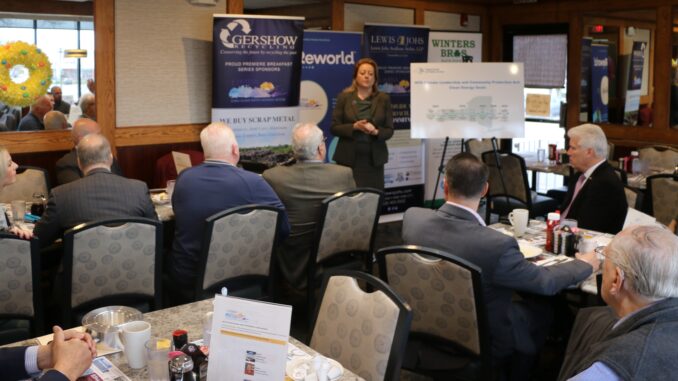
By Hank Russell
Carrie Meek Gallagher, the Long Island Regional Director of the Public Service Commission, was the guest speaker at the LIMBA (Long Island Metro Business Action) meeting that was held on April 4 at the Candlelight Diner in Commack. She discussed what the agency does and how the state is working to meet its clean energy goals.
The PSC regulates all utilities to ensure they are “safe, reliable and affordable,” Gallagher said. The Long Island regional office was established in 2013 as part of the LIPA (Long Island Power Authority) Reform Act due to the utility’s poor response to Superstorm Sandy.
Gallagher discussed the state’s move toward clean energy and its attempt to meet the goals set under the state’s Climate Leadership and Community Protection Act. “We have become more ambitious” in this area, she said, despite negative factors such as high prices, tariffs, the fluctuation of commodity prices and disruptions in the market. “New York State is not backing down from its climate goals, although it might take a little longer [to achieve them].”
She mentioned that the state achieved its goal of 6,000 megawatts of distributed solar ahead of schedule. Some of the other goals include:
- energy efficiency by reducing 185 trillion BTUs of electricity by 2025
- 10,000 megawatts of distributed solar energy by 2030
- 70% renewable energy by 2030
- 3,000 megawatts of battery storage by 2030
- 9,000 megawatts of offshore wind by 2035
- 100% emission-free energy production by 2040
- an 85% reduction in greenhouse gases by 2050
“The 2040 goal, we’re still managing it,” Gallagher said. “The timeline might be slightly delayed.” In order to achieve zero emissions, she said, the focus must shift to solar, wind, hydrogen, nuclear energy and biogas. There is also the use of DEFRs (Dispatchable Emission Free Resources), but, Gallagher said, the viability of that technology is “yet to be determined.”
The problem with the current energy infrastructure is that “it’s old,” she said. One solution is bidirectional energy so that it would come down from upstate New York to Long Island “and then come back up as needed.”
She also discussed the RAPID Act, a proposal to streamline the environmental review and permitting of major renewable energy generation and electric transmission facilities. There have been misnomers regarding the state taking control over the permitting process, but Gallagher said that is not the case.
“It doesn’t take away the ability of local governments to participate,” Gallagher said. “It also enhances public participation, so you get the best of both worlds.”
She noted that Long Island is at the forefront of the clean energy movement, with houses being powered by solar energy, wind and solar farms on the island and more motorists switching to electric and hybrid vehicles.
“Electricity is so critical,” Gallagher said. “We need that power to run our devices, our phones, our homes and our healthcare systems. … We need to be prepared. … There is no transition with transmission.”
The meeting was sponsored by North American Water Technologies, Inc. and International Brotherhood of Electrical Workers Local 1049.

